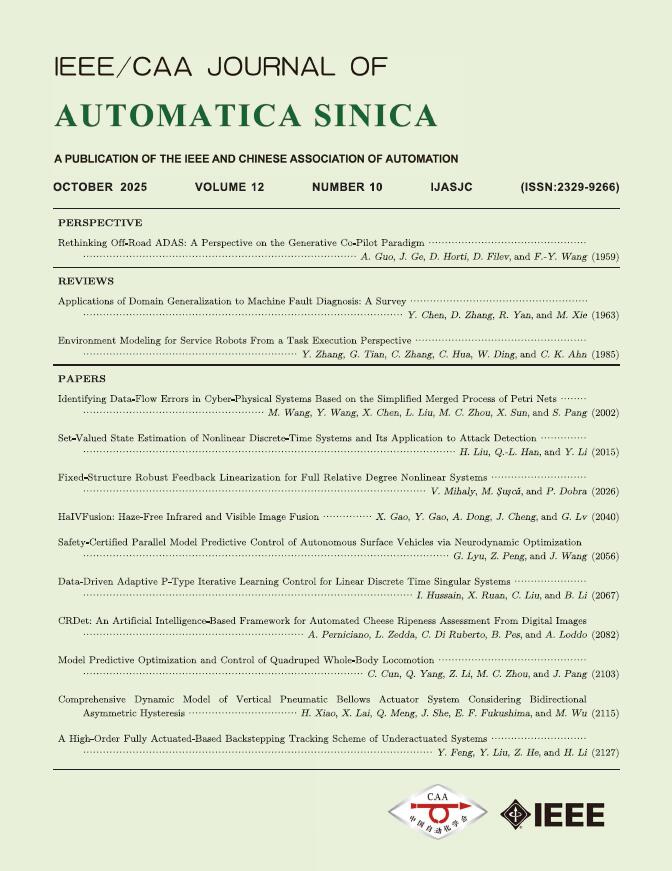 Volume 12
Issue 10
Volume 12
Issue 10
IEEE/CAA Journal of Automatica Sinica
| Citation: | K. Li, Y. Guo, G. Ran, Y. Lyu, and G. Ma, “Convex optimization-based model predictive control for mars ascent vehicle guidance system,” IEEE/CAA J. Autom. Sinica, vol. 12, no. 10, pp. 2159–2161, Oct. 2025. doi: 10.1109/JAS.2024.124587 |

| [1] |
P. Lu, H. Sun, and B. Tsai, “Closed-loop endoatmospheric ascent guidance,” J. Guid. Control Dyn., vol. 26, no. 2, pp. 283–294, 2003. doi: 10.2514/2.5045
|
| [2] |
W. Xinxin, L. Hongqian, X. Huang, Y. Yefeng, and Z. Zongyu, “Three-dimensional time-varying sliding mode guidance law against maneuvering targets with terminal angle constraint,” Chin. J. Aeronaut, vol. 35, no. 4, pp. 303–319, 2022. doi: 10.1016/j.cja.2021.05.019
|
| [3] |
W. He, X. Mu, L. Zhang, and Y. Zou, “Modeling and trajectory tracking control for flapping-wing micro aerial vehicles,” IEEE/CAA J. Autom. Sinica, vol. 8, no. 1, pp. 148–156, 2020.
|
| [4] |
R. Chai, A. Savvaris, A. Tsourdos, Y. Xia, and S. Chai, “Solving multiobjective constrained trajectory optimization problem by an extended evolutionary algorithm,” IEEE Trans. Cybern., vol. 50, no. 4, pp. 1630–1643, 2018.
|
| [5] |
R. Chai, A. Tsourdos, A. Savvaris, Y. Xia, and S. Chai, “Real-time reentry trajectory planning of hypersonic vehicles: A two-step strategy incorporating fuzzy multiobjective transcription and deep neural network,” IEEE Trans. Ind. Electron., vol. 67, no. 8, pp. 6904–6915, 2019.
|
| [6] |
H. Li and Y. Shi, “Event-triggered robust model predictive control of continuous-time nonlinear systems,” Automatica, vol. 50, no. 5, pp. 1507–1513, 2014. doi: 10.1016/j.automatica.2014.03.015
|
| [7] |
Z. Luo, B. Zhu, J. Zheng, and Z. Zheng, “Robust distributed model predictive control for formation tracking of nonholonomic vehicles,” IEEE/CAA J. Autom. Sinica, vol. 11, no. 2, pp. 560–562, 2024. doi: 10.1109/JAS.2023.123732
|
| [8] |
R. Chai, A. Tsourdos, H. Gao, Y. Xia, and S. Chai, “Dual-loop tube-based robust model predictive attitude tracking control for spacecraft with system constraints and additive disturbances,” IEEE Trans. Ind. Electron., vol. 69, no. 4, pp. 4022–4033, 2021.
|
| [9] |
X. Liu, “Fuel-optimal rocket landing with aerodynamic controls,” J. Guid. Control Dyn., vol. 42, no. 1, pp. 65–77, 2019. doi: 10.2514/1.G003537
|
| [10] |
W. Li, Y. Song, L. Cheng, and S. Gong, “Closed-loop deep neural network optimal control algorithm and error analysis for powered landing under uncertainties,” Astrodynamics, vol. 7, no. 2, pp. 211–228, 2023. doi: 10.1007/s42064-022-0153-1
|
| [11] |
A. C. Morelli, C. Hofmann, and F. Topputo, “Robust low-thrust trajectory optimization using convex programming and a homotopic approach,” IEEE Trans. Aerosp. Electron. Syst., vol. 58, no. 3, pp. 2103–2116, 2021.
|
| [12] |
B. Benedikter, A. Zavoli, G. Colasurdo, S. Pizzurro, and E. Cavallini, “Convex approach to three-dimensional launch vehicle ascent trajectory optimization,” J. Guid. Control Dyn., vol. 44, no. 6, pp. 1116–1131, 2021. doi: 10.2514/1.G005376
|
| [13] |
J. L. Junkins, A. Bani Younes, R. M. Woollands, and X. Bai, “Picard iteration, chebyshev polynomials and chebyshev-picard methods: Application in astrodynamics,” J. Astronaut. Sci., vol. 60, pp. 623–653, 2013. doi: 10.1007/s40295-015-0061-1
|
| [14] |
Y. Ma, B. Pan, and R. Yan, “Feasible sequential convex programming with inexact restoration for multistage ascent trajectory optimization,” IEEE Trans. Aerosp. Electron. Syst., vol. 59, no. 2, pp. 1217–1230, 2022.
|
| [15] |
Y. Wang, G. Ni, and Y. Liu, “Revised picard-chebyshev methods for perturbed orbit propagations,” J. Guid. Control Dyn., vol. 46, no. 1, pp. 161–170, 2023. doi: 10.2514/1.G006970
|
| [16] |
R. Chai, A. Tsourdos, H. Gao, S. Chai, and Y. Xia, “Attitude tracking control for reentry vehicles using centralised robust model predictive control,” Automatica, vol. 145, p. 110561, 2022. doi: 10.1016/j.automatica.2022.110561
|
| [17] |
D. Morgan, S.-J. Chung, and F. Y. Hadaegh, “Model predictive control of swarms of spacecraft using sequential convex programming,” J. Guid. Control Dyn., vol. 37, no. 6, pp. 1725–1740, 2014. doi: 10.2514/1.G000218
|
| [18] |
I. M. Ross, P. Sekhavat, A. Fleming, and Q. Gong, “Optimal feedback control: Foundations, examples, and experimental results for a new approach,” J. Guid. Control Dyn., vol. 31, no. 2, pp. 307–321, 2008. doi: 10.2514/1.29532
|